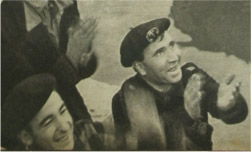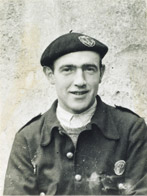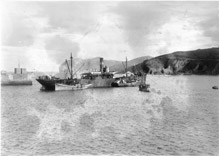 The Basque Government Ministry of Industry, which was headed by the socialist Santiago Aznar, was entrusted with managing the competences assumed by the provisional Basque Country Government in the field of the civilian navy. The Fisheries General Directorate and the Merchant Navy General Directorate were founded and headed by Santiago Chausson and Pantaleón León, respectively. In addition to organizing the many different merchant vessels under the Basque flat, the Merchant Navy General Directorate was entrusted with establishing a regular maritime link between Bilbao and Bayonne to transport mail, passengers and, sometimes, war supplies.
The Basque Government Ministry of Industry, which was headed by the socialist Santiago Aznar, was entrusted with managing the competences assumed by the provisional Basque Country Government in the field of the civilian navy. The Fisheries General Directorate and the Merchant Navy General Directorate were founded and headed by Santiago Chausson and Pantaleón León, respectively. In addition to organizing the many different merchant vessels under the Basque flat, the Merchant Navy General Directorate was entrusted with establishing a regular maritime link between Bilbao and Bayonne to transport mail, passengers and, sometimes, war supplies.
The Merchant Navy General Directorate also set up the Basque Sea Police Provisional Corps by means of a Decree by the Department of Industry on 3rd November 1936. Therefore, it had no link or direct relationship with the Auxiliary Navy. The Sea Police was founded to meet the need to patrol Bilbao port and docks and the estuary, and the other port under the control of the Basque Government, which had so far been the competence of various entities and Defence Boards of the towns. It was also in charge of overseeing the unloading of merchandise and controlling the movement of vessels that entered and left.
On 9th November, the Official Gazette of the Basque Country published the announcement for the competitive selection process for 95 sea policemen. The requirements were that the candidates had to be born in the Basque Country or have been resident there for at least three years, be a professional seaman between 30 and 45 years old and be endorsed by any of the trade union or political parties loyal to the Republican cause. In addition, a further 22 places were announced for the crews of the police surveillance motor boats. The personnel was distributed between the different trade union and political groups, with approximately a third being allocated to members of the STV and PNV, another third for the socialists and members of the UGT and the other posts to the other trade union and political groups.
 There were Sea Police posts in all Basque port, including the smallest: Bilbao (Campo Volantín), Zorroza-Olaveaga, Luchana-Baracaldo, Portugalete, Santurce, Las Arenas-Algorta, Plencia, Arminza, Baquio, Bermeo, Laida, Elanchove, Ea and Lequeitio. Its members were in charge of the surveillance on land and at sea. There were half a dozen motor launches for the maritime surveillance service, which included the V-7 of the Deputy Secretariat of the Civilian Navy, Euzkadi (former Lovic), Pirulo and Txirimol.
There were Sea Police posts in all Basque port, including the smallest: Bilbao (Campo Volantín), Zorroza-Olaveaga, Luchana-Baracaldo, Portugalete, Santurce, Las Arenas-Algorta, Plencia, Arminza, Baquio, Bermeo, Laida, Elanchove, Ea and Lequeitio. Its members were in charge of the surveillance on land and at sea. There were half a dozen motor launches for the maritime surveillance service, which included the V-7 of the Deputy Secretariat of the Civilian Navy, Euzkadi (former Lovic), Pirulo and Txirimol.
Its most outstanding performances include the one on the 8th January 1937, when, according to what was published in the press at the time, the motor boat Euzkadi, fitted with a machine gun and which operated out of Lequeitio, received a warning from the town’s lookout tower that five fishing boats, located roughly ten miles to the north of Ondárroa, had been taken by the destroyer José Luis Diez, which had had to leave them to go on another mission. They rapidly put to sea, setting course to the indicated location, until one of the vessels was sighted near to Motrico, as the others, of which only the smoke could be seen, had managed to put in to the coast. The fishing boat that the motor boat Euzkadi reached was the Nuestra Señora del Rosario, from Guetaria, which had set out to fish red bream. While shells were fired from Motrico against the motor boat without any damage or casualties, the Nuestra Señora del Rosario was taken to Lequetio and was requisitioned there. Its ten crew members, one from Motrico and the remainder from Guetaria, were released once they had been interrogated.
A few days later, on 18th January, the motor boat Pirulo used to locate mines discovered one 4 or 5 miles to the north of Punta Lucero. Once it was marked, the vessel notified the minesweepers. As they were sweeping the area, one of them, the Mari Toya, hit another mine and broke into a thousand pieces. The motor boat Pirulo that was just 50 metres away was the first to reach them and was able to rescue two survivors. Another vessel rescued a further two survivors.
 Sixteen people, including a soldier from the Garellano Regiment, were arrested in another operation on 10th February. They all tried to escape from Elanchove by bribing the engineer of a Sea Police vessel to take them to San Sebastián. But the engineer reported them to his head and they were all arrested and objects worth 60,000 pesetas seized from them.
Sixteen people, including a soldier from the Garellano Regiment, were arrested in another operation on 10th February. They all tried to escape from Elanchove by bribing the engineer of a Sea Police vessel to take them to San Sebastián. But the engineer reported them to his head and they were all arrested and objects worth 60,000 pesetas seized from them.
A few days later, on 18th February, a similar attempt was discovered when various individuals tried to flee to France from Bermeo, in the fishing boat Danielín, after bribing its skipper. The Sea Police bordered the Danielín shortly after it set sail, searched it and arrested the 13 people who were trying to flee, together with the whole crew. Items worth 20,000 pesetas were seized from the individuals arrested.
 But the Sea Police did not only frustrate many attempts to escape by sea to the enemy camp or were responsible for keeping order in the ports and for controlling the goods trade. It was also involved in the unloading of vessels in emergencies, as was the case of the Yorkbrook, which entered Bermeo loaded with weapons on 5th March, and which played a key role in the evacuation of Bilbao. They ordered the embarking of the evacuees and thanks to their work, all the useable vessels were removed from port and only the unusable equipment was sunk in the estuary. When Franco’s troops entered into Bilbao, the Corps was dismantled. A small group of policemen managed to escape to France on the motor boat Txirimol which entered Saint Jean de Luz on 17th June. The other motor boats were seized by the rebels.
But the Sea Police did not only frustrate many attempts to escape by sea to the enemy camp or were responsible for keeping order in the ports and for controlling the goods trade. It was also involved in the unloading of vessels in emergencies, as was the case of the Yorkbrook, which entered Bermeo loaded with weapons on 5th March, and which played a key role in the evacuation of Bilbao. They ordered the embarking of the evacuees and thanks to their work, all the useable vessels were removed from port and only the unusable equipment was sunk in the estuary. When Franco’s troops entered into Bilbao, the Corps was dismantled. A small group of policemen managed to escape to France on the motor boat Txirimol which entered Saint Jean de Luz on 17th June. The other motor boats were seized by the rebels.
